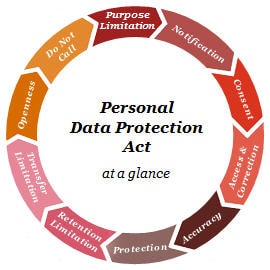
Real User Reviews: The Best AI Marketing Tools of 2024
August 16, 2024






In today's digital age, data is the new currency. With businesses collecting, processing, and storing vast amounts of personal data, safeguarding this information has become paramount. Enter the Personal Data Protection Act (PDPA) in Singapore, a critical piece of legislation that governs how organizations handle personal data. But what exactly is PDPA, and why is it so crucial for businesses?
The PDPA, or Personal Data Protection Act, is Singapore's primary data protection legislation, enacted to ensure that personal data is handled with care and respect. It establishes a framework for organizations to follow, promoting transparency and accountability in data management. In a world where data breaches can lead to severe financial and reputational damage, understanding and complying with the PDPA is not just a legal obligation—it's a business imperative.
So, why should businesses care about the PDPA? For one, the legal obligations under the PDPA are stringent, covering everything from how data is collected to how it's stored and eventually disposed of. Non-compliance isn't just a slap on the wrist; it can result in hefty fines, legal battles, and a loss of consumer trust. In essence, the PDPA is not just about avoiding penalties—it's about building a robust, trust-based relationship with customers.
As we delve deeper into the PDPA, we'll explore its key objectives, the principles it enshrines, and practical steps businesses can take to ensure compliance. Whether you're a small startup or a large corporation, this guide will help you navigate the complexities of the PDPA and safeguard your business against potential risks.

Key Objectives of the PDPA
At its core, the PDPA aims to protect personal data by regulating its collection, use, and disclosure by organizations. It seeks to strike a balance between the need for businesses to use data and the rights of individuals to protect their personal information. Here are the key objectives of the PDPA:
Scope of the PDPA
The PDPA applies to all organizations that collect, use, or disclose personal data in Singapore. This includes both private and public sector organizations, with the exception of government agencies. The act covers a wide range of data, including but not limited to names, identification numbers, contact details, and other information that can be used to identify an individual.
Recent Updates and Amendments
The PDPA is not static; it evolves to address emerging challenges in data protection. Recent updates to the PDPA have introduced new obligations for organizations and enhanced the rights of individuals.
Summary of Significant Changes
One of the key changes is the introduction of mandatory data breach notification requirements. Organizations are now required to notify the Personal Data Protection Commission (PDPC) and affected individuals if a data breach is likely to result in significant harm. This change emphasizes the importance of swift and transparent communication in the event of a breach.
Another significant amendment is the increased penalties for non-compliance. The PDPC now has the authority to impose higher fines on organizations that fail to meet their obligations under the PDPA. This serves as a strong deterrent against lax data protection practices.
How These Updates Affect Businesses
For businesses, these updates mean that the stakes are higher than ever. Organizations must be proactive in ensuring compliance with the PDPA, conducting regular reviews of their data protection policies and practices, and staying informed about legal developments. Failure to do so can result in severe consequences, both financially and reputationally.

The PDPA is built on a set of core principles that guide organizations in their data protection efforts. Understanding and adhering to these principles is crucial for achieving compliance.
Consent
Consent is the cornerstone of the PDPA. Organizations must obtain and manage consent from individuals before collecting, using, or disclosing their personal data. This consent must be informed, meaning that individuals must be made aware of the purposes for which their data is being collected and how it will be used.
Obtaining and Managing Consent
Obtaining consent involves more than just getting a signature on a form. Organizations must ensure that consent is given voluntarily and can be withdrawn at any time. This means providing individuals with clear and concise information about how their data will be used and giving them the option to opt-out if they choose.
Importance of Informed Consent
Informed consent is not just a legal requirement—it's a matter of ethical responsibility. When individuals are fully aware of how their data will be used, they are more likely to trust the organization handling their information. This trust is essential for building long-term relationships with customers and stakeholders.
Purpose Limitation
Under the PDPA, organizations are required to collect and use personal data only for the purposes for which it was collected. This principle, known as purpose limitation, ensures that data is not misused or repurposed without the individual's knowledge or consent.
Data Collection and Usage Constraints
Purpose limitation means that organizations must clearly define the purposes for which they are collecting data and ensure that the data is used only for those purposes. Any use of the data beyond the original scope requires the individual's consent.
Ensuring Data is Used for Intended Purposes
To comply with this principle, organizations should regularly review their data usage practices and ensure that they align with the purposes for which the data was collected. This may involve updating data protection policies, conducting audits, and providing training to employees.
Notification
Transparency is a key element of the PDPA, and notification plays a crucial role in achieving it. Organizations are required to inform individuals of the purposes for which their data is being collected, how it will be used, and who it will be shared with.
Informing Individuals of Data Collection Purposes
When collecting data, organizations must provide individuals with clear and concise information about the purposes for which their data is being collected. This information should be provided at the time of collection, either verbally or in writing.
Transparency in Communication
Transparency is not just about providing information—it's about making sure that the information is easy to understand. Organizations should use plain language in their communications and avoid technical jargon that could confuse or mislead individuals.
Access and Correction
The PDPA gives individuals the right to access their personal data and request corrections if the data is inaccurate or incomplete. This principle ensures that individuals have control over their data and can take steps to protect their privacy.
Rights of Individuals to Access and Correct Their Data
Individuals have the right to request access to their personal data and to ask for corrections if they believe the data is inaccurate. Organizations must respond to these requests in a timely manner and make the necessary corrections.
How Businesses Should Handle Requests
To handle access and correction requests, organizations should establish clear procedures and designate a responsible person or team to manage these requests. This ensures that requests are handled efficiently and in compliance with the PDPA.
Accuracy
Maintaining accurate and up-to-date data is essential for compliance with the PDPA. Inaccurate data can lead to mistakes, misunderstandings, and potential harm to individuals.
Maintaining Accurate and Up-to-Date Data
Organizations must take steps to ensure that the personal data they collect and use is accurate, complete, and up-to-date. This may involve conducting regular data reviews, implementing data validation processes, and encouraging individuals to update their information.
Regular Reviews and Updates
Regular reviews of personal data help organizations identify and correct inaccuracies before they cause problems. This proactive approach not only ensures compliance with the PDPA but also enhances the quality of the organization's data.
Protection
Data protection is a central tenet of the PDPA. Organizations must implement security measures to protect personal data from unauthorized access, collection, use, disclosure, or similar risks.
Implementing Security Measures
Security measures can include a wide range of technical and organizational practices, such as encryption, access controls, firewalls, and intrusion detection systems. These measures should be tailored to the specific risks faced by the organization.
Preventing Unauthorized Access, Collection, Use, Disclosure, or Similar Risks
Preventing unauthorized access requires a multi-layered approach that includes both physical and digital security measures. Organizations should also educate employees on data protection practices and the importance of safeguarding personal data.
Retention Limitation
The PDPA requires organizations to retain personal data only for as long as it is necessary to fulfill the purposes for which it was collected. Once the data is no longer needed, it should be securely disposed of.
Guidelines for Data Retention Periods
Organizations should establish clear guidelines for how long personal data will be retained. These guidelines should be based on legal requirements, business needs, and industry best practices.
Secure Disposal of Data No Longer Required
Secure disposal of personal data involves more than just deleting files. Organizations should use secure methods to permanently erase data, such as shredding physical documents or using specialized software to wipe digital files.
Transfer Limitation
When transferring personal data outside of Singapore, organizations must ensure that the data is adequately protected. This principle, known as transfer limitation, is designed to prevent data from being transferred to countries with weaker data protection laws.
Regulations on Transferring Data Outside Singapore
Organizations must take steps to ensure that any data transferred outside of Singapore is protected to the same standard as it would be within the country. This may involve using contracts, binding corporate rules, or other mechanisms to ensure data protection.
Ensuring Adequate Protection in Cross-Border Transfers
To comply with transfer limitation, organizations should assess the data protection laws of the destination country and implement appropriate safeguards to protect the data. This may involve using encryption, anonymization, or other techniques to secure the data during transit.
Accountability
Accountability is a fundamental principle of the PDPA, requiring organizations to take responsibility for their data protection practices. This includes appointing a Data Protection Officer (DPO) and establishing policies and procedures to ensure compliance.
Role of Data Protection Officer (DPO)
The DPO is responsible for overseeing the organization's data protection efforts, ensuring compliance with the PDPA, and serving as the point of contact for data protection matters. The DPO should have a thorough understanding of the PDPA and the organization's data protection practices.
Organizational Responsibility for Data Protection Compliance
Organizations are responsible for ensuring that they comply with the PDPA, even if they outsource data processing to third parties. This means that organizations must establish clear policies and procedures, conduct regular audits, and provide training to employees.

Achieving PDPA compliance requires a proactive approach that includes appointing a DPO, conducting data protection impact assessments, developing data protection policies, and implementing security measures.
Appointing a Data Protection Officer (DPO)
The first step in achieving PDPA compliance is to appoint a DPO. The DPO plays a crucial role in overseeing the organization's data protection efforts and ensuring compliance with the PDPA.
Role and Responsibilities of the DPO
The DPO is responsible for advising the organization on data protection matters, ensuring compliance with the PDPA, and serving as the point of contact for data protection issues. The DPO should also be involved in developing and implementing data protection policies and procedures.
Qualifications and Skills Needed
The DPO should have a thorough understanding of the PDPA and data protection practices. This may require formal training or certification in data protection. The DPO should also have strong communication and organizational skills, as they will be responsible for coordinating the organization's data protection efforts.
Conducting a Data Protection Impact Assessment (DPIA)
A Data Protection Impact Assessment (DPIA) is a tool that helps organizations identify and mitigate the risks associated with data processing activities. Conducting a DPIA is an essential step in achieving PDPA compliance.
Purpose of DPIA
The purpose of a DPIA is to assess the impact of data processing activities on individuals' privacy and identify any potential risks. This helps organizations take proactive steps to mitigate these risks and ensure compliance with the PDPA.
Steps Involved in Conducting a DPIA
The DPIA process involves several steps, including identifying the data processing activities to be assessed, analyzing the risks associated with these activities, and developing measures to mitigate these risks. The DPIA should be documented and reviewed regularly to ensure that it remains up-to-date.
Developing a Data Protection Policy
A data protection policy is a critical document that outlines the organization's approach to data protection. It should include the organization's data protection objectives, the principles it follows, and the procedures it has in place to ensure compliance with the PDPA.
Key Elements to Include in a Data Protection Policy
The data protection policy should include a clear statement of the organization's commitment to data protection, a description of the roles and responsibilities of key personnel, and detailed procedures for handling personal data. The policy should also outline the organization's approach to data breaches, data retention, and data transfer.
Importance of Employee Training and Awareness
Employee training and awareness are essential components of a successful data protection program. Employees should be trained on the organization's data protection policies and procedures, as well as their responsibilities under the PDPA. Regular training sessions and updates can help ensure that employees remain informed and vigilant.
Implementing Security Measures
Implementing robust security measures is a key step in achieving PDPA compliance. Security measures should be tailored to the specific risks faced by the organization and should include both technical and organizational practices.
Technical and Organizational Measures to Protect Data
Technical measures may include encryption, access controls, and intrusion detection systems, while organizational measures may include policies, procedures, and employee training. Together, these measures help protect personal data from unauthorized access, collection, use, disclosure, and other risks.
Best Practices for Data Encryption, Access Controls, and Monitoring
Best practices for data protection include encrypting sensitive data, using strong access controls to limit access to personal data, and monitoring data processing activities to detect and respond to potential threats. Regular security audits can help identify vulnerabilities and ensure that security measures remain effective.
Managing Data Breaches
Data breaches can have serious consequences for both individuals and organizations. Managing data breaches effectively is essential for mitigating these risks and ensuring compliance with the PDPA.
Protocols for Detecting and Responding to Data Breaches
Organizations should have clear protocols in place for detecting and responding to data breaches. These protocols should include procedures for identifying and containing the breach, notifying affected individuals and the PDPC, and taking steps to prevent future breaches.
Notification Obligations Under PDPA
Under the PDPA, organizations are required to notify the PDPC and affected individuals if a data breach is likely to result in significant harm. This notification must be made as soon as possible after the breach is discovered, and should include details of the breach and the steps the organization is taking to mitigate its impact.
Regular Audits and Reviews
Regular audits and reviews are essential for ensuring ongoing compliance with the PDPA. These audits should assess the organization's data protection practices, identify areas for improvement, and ensure that the organization remains compliant with the PDPA.
Importance of Regular Compliance Checks
Regular compliance checks help organizations identify and address any gaps in their data protection practices before they lead to non-compliance. These checks should be conducted by qualified personnel and should be documented for future reference.
Updating Policies and Procedures Based on Audit Findings
Based on the findings of regular audits, organizations should update their data protection policies and procedures to address any identified gaps or risks. This ensures that the organization remains compliant with the PDPA and continues to protect personal data effectively.

Achieving PDPA compliance is not without its challenges. Businesses often face difficulties in understanding the complexities of the PDPA, balancing compliance with business operations, and handling third-party data processors.
Understanding the Complexities of PDPA
The PDPA is a complex piece of legislation, and understanding its requirements can be challenging for businesses. The legal jargon and technical terms used in the PDPA can be difficult to navigate, making it challenging for businesses to understand their obligations.
Navigating Legal Jargon and Technical Terms
To overcome this challenge, businesses should seek legal advice or professional consultation to help them understand the PDPA and its requirements. This can help ensure that businesses are fully aware of their obligations and can take the necessary steps to achieve compliance.
Balancing Compliance with Business Operations
Balancing PDPA compliance with business operations can be challenging, particularly for small and medium-sized enterprises (SMEs) with limited resources. Achieving compliance requires a significant investment of time and resources, which can impact business operations.
Aligning Data Protection with Business Objectives
To balance compliance with business operations, organizations should align their data protection efforts with their business objectives. This may involve prioritizing data protection initiatives that are critical to the business and finding ways to integrate compliance into existing processes.
Minimizing Operational Disruption
To minimize operational disruption, businesses should take a phased approach to achieving PDPA compliance. This allows organizations to gradually implement data protection measures without overwhelming their resources or disrupting their operations.
Handling Third-Party Data Processors
Many businesses rely on third-party data processors to handle their data processing activities. Ensuring that these third parties comply with the PDPA can be challenging, particularly if they are located outside of Singapore.
Ensuring Third-Party Compliance
To ensure third-party compliance, organizations should conduct due diligence on their data processors and include data protection clauses in their contracts. These clauses should outline the third party's obligations under the PDPA and provide for regular audits to ensure compliance.
Drafting and Managing Data Processing Agreements
Drafting and managing data processing agreements is an essential part of ensuring third-party compliance. These agreements should clearly define the roles and responsibilities of the parties involved, including the data protection measures that the third party is required to implement.
PDPA compliance is essential for businesses operating in Singapore. By understanding the requirements of the PDPA and taking proactive steps to achieve compliance, businesses can protect personal data, build trust with customers, and avoid costly penalties.
The Importance of PDPA Compliance
Achieving PDPA compliance is not just a legal requirement; it's also a business imperative. By protecting personal data, businesses can build trust with customers, enhance their reputation, and gain a competitive advantage.
Long-Term Benefits of Data Protection
In addition to avoiding penalties, businesses that achieve PDPA compliance can enjoy long-term benefits, such as increased customer loyalty, improved operational efficiency, and reduced risk of data breaches.
Building Trust with Customers and Stakeholders
Protecting personal data is key to building trust with customers and stakeholders. By demonstrating a commitment to data protection, businesses can enhance their reputation and foster long-term relationships with their customers.
Final Tips for Businesses
To achieve PDPA compliance, businesses should appoint a DPO, conduct regular audits, and provide ongoing training to employees. By staying informed of the latest developments in data protection laws and implementing best practices, businesses can ensure ongoing compliance with the PDPA.
Quick Checklist for Ensuring PDPA Compliance
Encouragement to Stay Updated with Ongoing Changes in Data Protection Laws
Data protection laws are constantly evolving, and businesses must stay updated with the latest changes to ensure ongoing compliance. By staying informed and adapting to new requirements, businesses can continue to protect personal data and maintain their competitive edge.